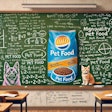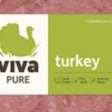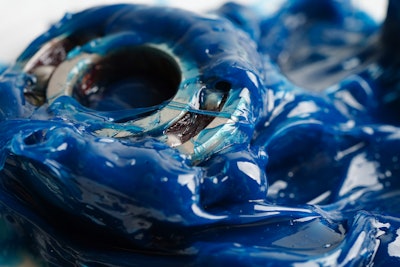
In the feed milling industry, qualified maintenance technicians are becoming more difficult to hire or retain. Consequently, we increasingly depend on production operators to conduct daily preventive maintenance on equipment. As an industry and as managers, investment is needed in good basic training for maintenance technicians without fear that they will leave the company once trained. With their insight and understanding of equipment intricacies, operators have always been vital to the maintenance team in maximizing machine lifetime, and can complement a facility's autonomous maintenance program.
The concept of autonomous maintenance holds two primary principles:
- Proper asset use: Running machinery appropriately to prevent deterioration and unplanned downtime.
- Sufficient asset maintenance: Keeping equipment operational and repairing when needed. The result is improved safety, quality product and overall equipment effectiveness.
With proper basic training in the key areas of bearing greasing, gear oil changing, belt tensioning and good housekeeping, employees are upskilled, increasing safety and product quality while improving machine uptime.
Bearing greasing
Equipment bearings are either relubricatable or maintenance-free. There are generally two schools of thought on bearing relubrication. The first and, unfortunately, the most common, is lubricating the bearing until the seal purges and clean grease is visible. It is rarely good practice to purge a seal. Seals are designed to keep product (like grease) in or out, and a purge opens it to the possibility of contamination. For many bearing types, it is best to replace the insert or bearing if the seal is purged. In some cases, like pellet mills and rolls with mechanical seals, only rarely, and if the manufacturer recommends a seal purge, should grease expel from the seals when lubricated.
The second method is to run the bearing with the factory fill amount and only grease per manufacturer specifications. Sometimes, the factory fill is sufficient, and no further lubrication is necessary. This ensures that the seal is not compromised, avoiding contamination ingress.
This principle of not overgreasing seems simple, and it can be, but human nature and lack of training can make it difficult. One myth is that “a little grease is good, so a lot is great.” If grease is pumped into a bearing until a glob of grease seeps out from the seal, the seal will blow out and allow contaminants to enter the bearing.
If unaddressed, the issue will continue. The next time a technician sees this glob of grease, they may mistakenly think the bearing doesn’t need grease when the opposite is true. The bearing needs it more than ever to close the conduit for contaminants.
Another dangerous point when overgreasing is the risk of overheating the bearing due to overfilling its housing. This causes fluid friction because grease cannot transfer heat.
Undergreasing is just as serious of an issue for the bearing’s health. Not having enough grease in the housing can allow contaminants into the void or it can cause overheating from the friction of moving parts in equipment such as elevator legs and drag or screw conveyors. Tables 1 and 2 provide guidelines for proper bearing greasing. (Consult your bearing supplier for specific schedules and amounts based on specific applications.)
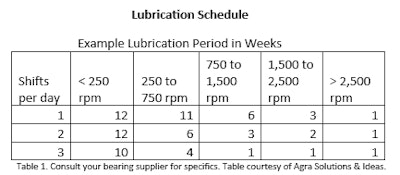

Gearbox oil checking and changing
Checking gearbox oil for abnormalities involves the senses: listening for noises and vibration, looking for leaks and cracks, feeling for hot or cold, and sniffing for burning or unusual odors. These practical, simple checks should be done every time you are near a gearbox, in addition to the regular maintenance schedules.
Beyond using your senses, advanced technology can be an immense cost saver. For example, vibration analysis is an advanced reliability-centered maintenance technique with many gearboxes operating in a noisy environment.
The following additional considerations will be helpful in this routine:
- Shaft seals. Look for oil leaks at the gearbox’s input and output shafts. Leaks mean failed seals (allowing entry of dust, debris and water) and possible lubrication loss. Replace leaking seals immediately to avoid internal gearbox contamination or insufficient gear oil.
- Temperature. Check for signs of overheating, such as dark oil in the sight glass or discolored or burnt exterior paint. Monitor the gearbox temperature regularly and use an infrared thermometer to watch for abrupt temperature changes.
- Housekeeping. While the presence of dirt and dust is unavoidable in most facility environments, minimizing its dangerous effects on the worksite is critical. Increased operating temperature or gearbox contamination are possible consequences of poor housekeeping.
- Breathers. It is also essential to prevent water, dust and debris from entering the gearbox via the breather. The correct breather type should be selected for the application and always kept clean to allow the gearbox to breathe easily.
- Lubrication. Always follow the gearbox manufacturer’s specifications for type, grade and amount. Change the oil regularly according to the gearbox manufacturer's recommendations based on the environment and run time. Pay close attention to the color of the oil removed from the gearbox; inspect for metal chips on the magnetic plug or in the oil and note if the oil volume is too low.
Drive belt tensioning tips
Again, an operator's four senses will be the main tool for helping maintain drive belt life expectancy. To check for abnormalities: listen (noises, vibration), look (cracks), feel (hot bearings or motor) and smell (burning, unusual odors). Every abnormality observed indicates a problem that likely requires corrective action. Table 3 outlines common symptoms, probable causes and recommended corrective actions.
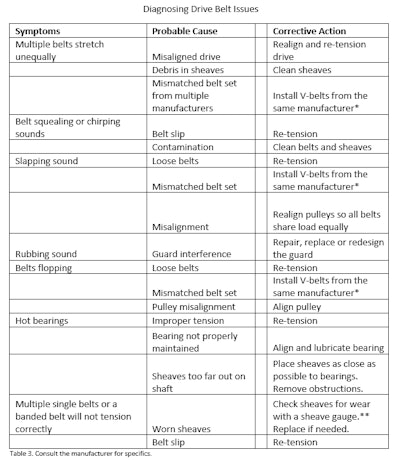 *With today’s continual improvements in belt manufacturing quality (from top-tier suppliers), matching belt sets are no longer necessary. However, replacing all belts on a multiple-belt drive system with the same manufacturer is critical. It ensures that all belts perform as desired with similar life through the system and eliminates any variables in quality from different manufacturers.
*With today’s continual improvements in belt manufacturing quality (from top-tier suppliers), matching belt sets are no longer necessary. However, replacing all belts on a multiple-belt drive system with the same manufacturer is critical. It ensures that all belts perform as desired with similar life through the system and eliminates any variables in quality from different manufacturers.
**Checking sheave wear is the most overlooked step in V-belt troubleshooting. Ask your power transmission vendor for a sheave gauge set if you don’t have one.
General housekeeping
Good housekeeping is critical in feed milling operations. It must be incorporated into every facility’s safety, quality and maintenance programs to detect issues and abnormalities that demand root-cause analysis. Contaminants resulting from poor housekeeping cause equipment failures and operational inefficiencies.
A clean and safe environment will help machinery operate more efficiently. Walk the floor and use the senses to discover potential problems needing attention. For example, if equipment is clean, any leaking fluids — possibly indicating an overheating issue — may more readily be seen or smelled.
By providing basic training in the key areas of bearing greasing, gear oil changing, belt tensioning, and good housekeeping, employee involvement will rise to pride and ownership in their individual craft. A strong preventive maintenance program will improve safety and environmental performance, maximize the lifetime value of feed milling equipment, and provide opportunities to lower costs and increase profits.
AJ Bubela, project manager, Agra Solutions & Ideas, has more than 23 years of experience in project management, maintenance and reliability, and plant management. Bubela has a bachelor’s in poultry science and food engineering from Mississippi State and a master’s in agribusiness from the University of Tennessee. He can be reached at [email protected].
Peter Jean, account representative, Motion, has 18 years of sales and sales management experience in the industrial power transmission and bearing manufacturing industries. Jean has a bachelor’s in business and communication from Arizona State University. He can be reached at [email protected].











